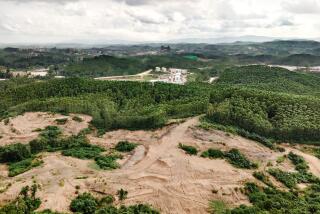Karadzic Breaks Ground for âSerb Sarajevoâ
PALE, Bosnia-Herzegovina â While most of the West looks for his political demise, Radovan Karadzic is dreaming of the future.
Twin golden domes grace a magnificent cathedral; a sparkling new presidency building borders the central square; a 15-story clock tower pierces the crisp air--these are the fantastic plans Karadzic has for his New Serb Sarajevo, a metropolis he wants to build on the slopes of two mountains, the Jahorina and Romanija, just south of the real Sarajevo.
On a sunny morning the other day, Karadzic broke ground on the piece of real estate that will serve as the beachhead for the new capital. Located, conveniently, a little more than half a mile from Karadzicâs own home here in Pale--just in case an anticipated rise in property values furnishes a windfall--the lush hillside was the scene of a solemn ceremony as Karadzic laid red stakes as grazing cows looked on.
The city of Karadzicâs dreams would cost billions of dollars and contrast sharply with the reality of current Pale, a dilapidated country village of summer homes near Olympic ski runs. It is from here that Karadzic is accused of directing a 43-month war that killed tens of thousands of people.
But Karadzic is taking it all quite seriously. Earlier this year, he commissioned an architectural firm in Belgrade, the Serbian and Yugoslav capital. It drafted blueprints and built models to scale, and work has begun on a new road connecting Pale and the nearby Serbian town of Lukavica.
Whether the project will ever progress further is unclear; what is clear is the determination of the Bosnian Serb leadership to remain separate from the Muslim-Croat half of Bosnia-Herzegovina by building an alternative Sarajevo.
And clear too is Karadzicâs determination to remain part of this picture. Under the U.S.-brokered peace accord that halted Bosniaâs war in December, the Bosnian Serbs were awarded their ministate, Republika Srpska, but lost most of Sarajevo to the Muslim-Croat authorities. Thousands of Serbs fled to miserable lives as refugees in search of a new city.
âWe do not have support from the international community for what we are doing,â said Mirko Sarovic, already designated mayor of Serb Sarajevo. âThey want us to go back to Sarajevo. But we will never go back to Sarajevo the way it is.
âOur wish is to build a Serb town, and we are forced to do it alone,â Sarovic continued, speaking in his office and seated under a large wall photograph of Karadzic. âWe have the plans. It depends on the money. Sooner or later, we will do it all. No one can stop us.â
But utopia will take time. Because of the heavy machinery that Serbs took when they abandoned Sarajevoâs formerly Serbian suburbs, Sarovic said, planners of the new city will be able to build factories and establish an industrial base. Thatâs key to the first phase of the project, which also includes housing for about 5,000 families scheduled to be constructed by the end of next year.
The other elements--the Orthodox church, the clock tower, not to mention a university, a medical center, swimming pool, tennis courts and a national theater with a 72-foot revolving stage--will have to wait. But the price tag, projected at about $7 billion, seems a bit steep for a bankrupt regime said to subsist on black-market earnings.
Sarovic acknowledged that money is the biggest problem. But he said he is confident that âfriendsâ--as in countries sympathetic to the Serbs, such as Greece and Israel--along with exiled Serbs the world over, will contribute.
One of the hired architects, Ivan Antic, told the Belgrade newsmagazine Vreme that Pale, which had about 16,000 residents before the war, would grow into a city of 140,000 in its new incarnation.
The ambitious plans of Karadzic, who has been indicted on war crimes charges that include genocide, may assuage an unhappy Bosnian Serb public that obeyed the orders to leave Sarajevo but is now in dire straits. They could serve as a comforting dream for Serbs like Jovanka Demirovic, a government secretary in Sarovicâs office, who abandoned nice homes and are crammed into makeshift refugee shelters.
âWe believe in our leaders,â she said, âand that they will do something for us.â
More to Read
Sign up for Essential California
The most important California stories and recommendations in your inbox every morning.
You may occasionally receive promotional content from the Los Angeles Times.











